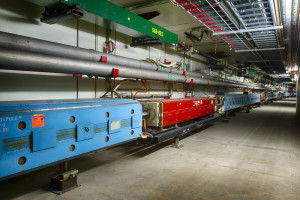Most powerful high-energy particle beam for a neutrino experiment ever generated

Fermilab’s Main Injector accelerator, one of the most powerful particle accelerators in the world, has just achieved a world record for high-energy beams for neutrino experiments. Photo: Fermilab
A key element in a particle-accelerator-based neutrino experiment is the power of the beam that gives birth to neutrinos: The more particles you can pack into that beam, the better your chance to see neutrinos interact in your detector. Today scientists announced that Fermilab has set a world record for the most powerful high-energy particle beam for neutrino experiments.
Scientists, engineers and technicians at the U.S. Department of Energy’s Fermi National Accelerator Laboratory have achieved for high-energy neutrino experiments a world record: a sustained 521-kilowatt beam generated by the Main Injector particle accelerator. More than 1,000 physicists from around the world will use this high-intensity beam to more closely study neutrinos and fleeting particles called muons, both fundamental building blocks of our universe.
The record beam power surpasses that of the 400-plus-kilowatt beam sent to neutrino experiments from particle accelerators at CERN.
Setting this world record is an initial step for the Fermilab accelerator complex as it will gradually increase beam power over the coming years. The next goal for the laboratory’s two-mile-around Main Injector accelerator — the final and most powerful in Fermilab’s accelerator chain — is to deliver 700-kilowatt beams to the laboratory’s various experiments. Ultimately, Fermilab plans to make additional upgrades to its accelerator complex over the next decade, achieving beam power in excess of 1,000 kilowatts, also referred to as 1 megawatt.
“We have the world’s highest-power beam for neutrinos, and we’re only going up from here,” said Ioanis Kourbanis, head of the Main Injector Department at Fermilab.
Laboratory-made neutrino experiments start by accelerating a beam of particles, typically protons, and then smashing them into a target to create neutrinos. Scientists then use particle detectors to “catch” as many of those neutrinos as possible and record their interactions. Neutrinos rarely engage with matter: Only one out of every trillion emerging from the proton beam will interact in an experiment’s detector. The more particles in that beam, the more opportunities researchers will have to study these rare interactions.
The amped-up particle beam provided by the Main Injector enriches the lab’s neutrino supply, positioning Fermilab to become the primary laboratory for accelerator-based neutrino research. Neutrinos are also made in stars and in the Earth’s core, and they pass through everything — people and planets alike.
“The idea is that if you build a more intense beam, neutrino scientists from around the world will beat a path to your door,” said Fermilab Deputy Director Joe Lykken. “This is exactly what’s happening.”
Fermilab currently operates four neutrino experiments: MicroBooNE, MINERvA, MINOS+ and the laboratory’s largest-to-date neutrino experiment, NOvA, which sends particles from Fermilab’s suburban Chicago location to a far detector 500 miles away in Ash River, Minnesota. The laboratory is working with scientists from around the world on expanding its short-baseline neutrino program and would also serve as host to the proposed flagship Long-Baseline Neutrino Facility and Deep Underground Neutrino Experiment, or DUNE. Scientists aim to address basic questions about the mass and properties of each kind of neutrino as well as the role neutrinos played in the evolution of the universe.
“Reaching this milestone is a fantastic achievement for Fermilab; beam power is everything in our field,” said DUNE co-spokesperson Mark Thomson of the University of Cambridge. “The ability for Fermilab to deliver, yet again, gives the international neutrino community huge confidence in the future U.S.-hosted neutrino program.”
Fermilab is also preparing to operate two experiments for studying muons, short-lived particles that could reveal secrets about the earliest moments of the universe. The increased beam power will also benefit the Fermilab Test Beam Facility, one of the few facilities in the world that provides muons, pions and other particles that researchers can use to test their particle detectors.
Since 2011, Fermilab has made significant upgrades to its accelerators and reconfigured the complex to provide the best possible particle beams for neutrino and muon experiments. With the dedicated work of the Fermilab Accelerator Division, the Main Injector is on track to nearly double its Tevatron-era beam power by 2016.
“Fermilab’s beamline has been a tremendous driver of neutrino science for many years, and the continued improvements to the intensity mean that it will remain a driver for many years to come,” said Indiana University’s Mark Messier, co-spokesperson for the NOvA experiment.
Fermilab is America’s premier national laboratory for particle physics and accelerator research. A U.S. Department of Energy Office of Science laboratory, Fermilab is located near Chicago, Illinois, and operated under contract by the Fermi Research Alliance LLC. Visit Fermilab’s website at www.fnal.gov, and follow us on Twitter at @Fermilab.
The DOE Office of Science is the single largest supporter of basic research in the physical sciences in the United States and is working to address some of the most pressing challenges of our time. For more information, please visit science.energy.gov.



